| Veneto region | |
| Capital | Venice |
|---|---|
| Residents | 4.905.854 (2019) |
| surface | 18,339 km² |
| no tourist info on Wikidata: | |
| location | |
 | |
The region Veneto (ital. Veneto) is in the northeast Italy. The capital is Venice.
Regions

Administratively, Veneto is divided into 7 provinces:
In terms of landscape, the region can be divided into a mountain landscape and a low plain. The mountain landscape stretches from the Dolomites to the Pre-Alps. Lay here
- Cadore - Valley of the Piave river between the Dolomites to the north and the city Belluno in the south. That closes the Cadore
- Val Belluna, the valley of the Piave between Belluno and Feltre, at.
- Valle d'Ampezzo - This Dolomite valley with the resort Cortina d'Ampezzo flows into the Cadore valley.
- Seven parishes (Sette Comuni) - German language island on the border with Trentino-South Tyrol; main place Asiago.
- The east bank of the Lake Garda also belongs to Veneto.
Most of the region lies in a low plain, only interrupted by a few hilly landscapes:
- Venetian Po Valley see the article Padua (province), Treviso (Province) and Rovigo (province)
- Venetian Adriatic Coast with lagoons all around Venice, see article Venice (province)
places


- 1 Venice
 - unique lagoon city, old art metropolis and capital of Veneto
- unique lagoon city, old art metropolis and capital of Veneto

- 2 Padua
 - old and renowned university town, pilgrimage site of Saint Anthony
- old and renowned university town, pilgrimage site of Saint Anthony - 3 Treviso

- 4 Verona
 - with the Roman arena and place of action of Romeo and Juliet
- with the Roman arena and place of action of Romeo and Juliet - 5 Vicenza
 - City of the villas of the Renaissance architect Palladio
- City of the villas of the Renaissance architect Palladio
- 6 Bassano del Grappa
 - picturesque old town at the foot of the foothills of the Alps with a famous wooden bridge over the Brenta
- picturesque old town at the foot of the foothills of the Alps with a famous wooden bridge over the Brenta - 7 Belluno

- 8 Bibione
 - Seaside resort on the northern Adriatic
- Seaside resort on the northern Adriatic - 9 Caorle

- 10 Cortina d'Ampezzo
 - glamorous holiday and winter sports resort (1224 m) in the eastern Dolomites
- glamorous holiday and winter sports resort (1224 m) in the eastern Dolomites - 11 Chioggia
 - Port city in the south of the Venice lagoon, called "Little Venice" because of the similarity to its large neighbor
- Port city in the south of the Venice lagoon, called "Little Venice" because of the similarity to its large neighbor - 12 Jesolo
 - Seaside resort near Venice
- Seaside resort near Venice - 13 Malcesine
 - on the east bank of Lake Garda
- on the east bank of Lake Garda - 14 Montegrotto Terme

Other goals
background
The region is called in Italian Veneto, where the first syllable is stressed and the first 'e' sounds like an 'ä'.
The region is named after the People of Veneterthat settled here in antiquity. In the 2nd century Veneto was gradually integrated into the Roman Empire, the founding of Aquileia, one of the most important Roman cities in Northern Italy. The Roman region Venetia belonged to the province Gallia Cisalpina and included approximately the present-day regions of Veneto, Friuli Venezia Giulia and Trentino-South Tyrol. To this day they are sometimes referred to as Triveneto or Tre Venezie (the "three Veneto") summarized. Various Germanic peoples migrated through the region during the migration period. The Venetian coast belonged to the Eastern Roman Empire from the 6th to 11th centuries, while the interior of the country belonged to the Longobard Empire and from the time of Charlemagne to the Franconian Empire.
_Tempera_on_canvas,_Palazzo_Ducale,_Venice.jpg/220px-1516_Vittore_Carpacci,_The_Lion_of_St_Mark_(detail)_Tempera_on_canvas,_Palazzo_Ducale,_Venice.jpg)
That was very formative for the history of Ventiens Republic of Venice. According to legend (which cannot be historically verified), Venice was founded in 421. The first doge (from Latin Dux= 'Duke' or 'Führer') was chosen in 697, which is considered the starting point of the Venetian aristocratic republic. Relics of Saint Mark were brought to Venice in 828 and he has been the patron saint of both the city and the region ever since. The lion of St. Mark (a winged lion with a Bible) and the red and gold flag are symbols of Venice as well as Veneto. From 840 the Franconian Empire recognized the independence of the republic, its traditional nickname Serenissima ('The most serene') is.
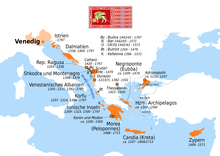
In the 10th century Venice acquired the first colonies around the Adriatic, until after Dalmatia, so began his rise to a great power. At that time, the interior of Veneto did not belong to the Seafarers' Republic, but to various principalities, in particular the Margraviate of Verona. In the High Middle Ages, several rival city-states developed from this (Verona, Padua, Treviso and Vicenza), which were under the rule of noble families (e.g. the Scaligians). The University of Padua was founded in 1222, making it one of the oldest in Europe.
In the 14th and 15th centuries, the rule of the Republic of Venice also spread to the interior, the so-called Terraferma (Mainland) about. This is how Veneto came into being in its modern form. At the transition from the Middle Ages to the modern era around 1500, Venice and Genoa dominated trade in the entire Mediterranean area, the Venetian colonial empire extended until after Cyprus. The territory of the republic was secured in the 15th to 17th centuries with what were then modern fortresses and bastions - both on the land and on the sea side, the remains of which are now part of the world cultural heritage. With the expansion of the Ottoman Empire in the eastern Mediterranean in the 15th and 16th centuries, however, the decline of Venice began.
Venice and Veneto played a formative role in European art history, especially during the late Gothic and Renaissance periods. In the 16th century the venetian school as the non-plus-ultra in European painting. Giotto, Donatello, Giovanni Bellini, Tizian, Tintoretto and Bernardo Bellotto ("Canaletto") are among the most famous artists who came from Veneto or who worked here. In architecture, Andrea Palladio was the most important Renaissance master builder in Northern Italy. The most important Venetian composer is likely to be Antonio Vivaldi.
The Republic of Venice ended in 1797 with the conquest by Napoleon, Veneto then belonged to the Napoleonic Kingdom of Italy. After the Congress of Vienna in 1815, Ventien came to the Kingdom of Lombardy-Venetia, a land of the Habsburg Empire of Austria, Venice was its capital. Only in the course of the Risogimento, the national unification of Italy, Veneto came to the Kingdom of Italy. During the First World War, the front between Italy and Austria ran through the north of Veneto. One of the decisive battles took place at Vittorio Veneto.
For a long time Veneto was a relatively poor and small farming region, from which many emigrated (especially to Brazil, Argentina and Switzerland). In the wake of the Italian economic miracle of the 1960s and 70s, however, it turned into one of the most industrialized and economically strongest regions in Italy. Since then there has been an increasing autonomist or even nationalist movement that emphasizes the independence of Veneto and strives for greater self-government or even the independence of Veneto. In a non-binding referendum in October 2017, with a participation of 57% of the electorate, 98% spoke in favor of greater autonomy for the region within Italy. Until the 1980s, Veneto was a stronghold of the Christian Democrats, with election results of 50 to 60 percent. Today the Lega Nord (Liga Veneta) is stronger here than anywhere else.
language
Colloquial languages are Italian and Venetian. The latter is not a dialect, but its own Romance language (the Venetians attach great importance to this), which is related to Italian, but also to Romansh. Venetic is used more in colloquial situations, with family and acquaintances, standard Italian in official contexts and with strangers.
In Venice and Verona they are very much geared towards international tourists, here you can get along well with English or even German. Anyone who moves outside the beaten tourist path should try at least a few bits of Italian.
getting there
By plane
Largest airport in the region is Venice “Marco Polo” (VCE) with numerous direct connections from German-speaking countries. The airports are significantly smaller, but can also be reached directly from D / A / CH Verona Villafranca (VRN) and Treviso (TSF; is mainly used by Ryanair used).
By train
Venice, Mestre, Padua, Verona and Vicenza from the high-speed trains Frecciarossa and Italo served.
From the German-speaking area, night trains and car travel trains are the most popular. ÖBB Nightjet lines run from Vienna via Klagenfurt or from Munich via Salzburg to Padua, Vicenza, Verona and Peschiera del Garda (with car transport from Vienna to Verona) or from Vienna via Linz or from Munich via Salzburg to Treviso and Venice. There is also the UEX Holiday Express from Hamburg-Altona via Hanover to Verona.
During the day, the Eurocity runs every two hours from Munich via Innsbruck and Bolzano to Verona (total travel time 5½ hours) and twice a day the RailJet from Vienna via Villach to Venice (7½ hours). From Switzerland a Eurocity runs from Zurich to Verona, Padua and Venice only once a day (Zurich – Verona in 5:20 hours), otherwise you have to change trains in Milan.
In the street
From Germany (as well as western Austria and South Tyrol) you usually drive on the Brenner motorway to Trento, and then either on the A22 to Verona, or - if you prefer to travel a little slower - on the scenic SS47 through the foothills of the Alps cut Sugana Valley to Bassano del Grappa and Padua.
From the east and south of Austria you can take the south (A2) or Alpe-Adria motorway (A23) past Villach and Udine into the Venice area. From Switzerland, the route typically leads through Ticino, past Milan, Brescia and the southern shore of Lake Garda.
If you want it to be particularly scenic, you can also travel from Bolzano via the Great Dolomite Road drive to Cortina d’Ampezzo.
By bicycle
The long-distance cycle path Via Claudia Augusta leads from Donauwörth and Augsburg over the Alps to Verona and Venice (approx. 700 km in total). In addition, the EuroVelo route EV7 ("Sun Route") leads from Linz and Salzburg to Lake Garda.
mobility
The region is quite dense railroadnetwork. All major cities are served by Trenitalia or regional trains Sistemi Territoriali (ST) served. Especially in the core of the region, between Venice, Padua, Treviso and Castelfranco, regional trains run at a tight pace.
But if you also want to visit sights outside the cities or the sparsely populated parts of Veneto, we recommend a automobile. The most important road axis in the region is the A4 motorway (“Autostrada Serenissima”), which connects Venice, Padua, Vicenza and Verona. From this branch to the north the A27, which opens up Treviso, Conegliano, Vittorio Veneto and Belluno, to the south the A13 to Rovigo and the A31 in both directions.
There is one between Padua and Venice shipbare waterway over the Brenta Canal. Excursion boats (providers Batelli del Brenta, Il Burchiello), from which you can see the historic mansions that line the canal. In addition, you can sail across the Fissero Canal and the Tartaro – Canalbianco – Po di Levante river system from Mantua through the Po Valley in southern Veneto to the Adriatic Sea.
There is a wheelroute network. Route I1, for example, leads from Lake Garda via Verona, Vicenza and Padua to Venice (a total of 185 km). The "Ring of Veneto" (Route I2) leads a total of 305 km from Venice via Chioggia, Abano Terme, Vicenza, Bassano del Grappa and Treviso back to Venice.
Tourist Attractions
Venice is one of the Italian regions with the most world heritage sites:
- Venice and its lagoon: the SerenissimaThe former capital of a rich and powerful seafaring republic with its canals, palaces and gondolas, built on over a hundred islands, is unique and attracts people from all over the world to its bond. Fortunately, apart from St. Mark's Square and the Grand Canal, there are still districts that are not overcrowded by tourists. The neighboring islands of the lagoon (especially the glassblower island Murano) are also worth seeing.
- Palladian villas: Andrea Palladio was the most important Renaissance architect in Northern Italy. He designed over 80 larger structures, including country estates, city palaces and churches, mainly in the city and province of Vicenza. They are of a special balance and aesthetics, the villas fit perfectly into the respective landscape, mostly they are also surrounded by beautiful gardens. Among the most important of them are La Rotonda, Villa Barbaro in burl, Villa Foscari in Mira and Villa Emo in Vedelago. Other outstanding works by Palladio are the churches of San Giorgio Maggiore and Il Redentore in Venice, the Teatro Olimpico and the Basilica Palladiana in Vicenza and the Old Bridge in Bassano del Grappa.
- Old town of Vicenza

St. Mark's Square and Doge's Palace
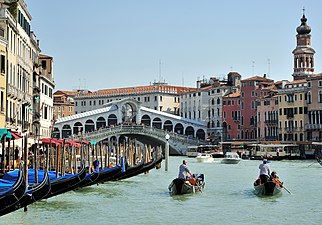
Rialto Bridge

Villa Emo
_scena_.jpg/263px-Interior_of_Teatro_Olimpico_(Vicenza)_scena_.jpg)
Teatro Olimpico, Vicenza
- Old town of Verona: cultural and historical sights from antiquity, the Middle Ages and the Renaissance, in particular the Roman arena and the Castelvecchio castle; Another visitor magnet is the house of the Capulets with the "Juliet's balcony"
- Botanical Garden Padua: the oldest botanical garden in the world still in its original location, founded in 1545.
- The fortified city Peschiera del Garda, Part of the defense structures of the Republic of Venice from the Renaissance period.
- Prehistoric pile dwellings from the 2nd and 3rd millennium BC In Peschiera del Garda, Cerea and Arquà Petrarca

Juliet's balcony, Verona

Padua Botanical Garden
.jpg/339px-Peschiera_del_Garda_-_panoramio_(1).jpg)
Peschiera del Garda fortress
Further:
- Padua: Fresco paintings by Giotto (14th century) in the Scrovegni Chapel, other churches and palaces in Padua; Basilica of Saint Anthony in Padua, one of the most visited Catholic shrines in Italy; Palazzo della Ragione (medieval court palace, the large wooden vault of the council chamber is one of the most extraordinary architectural creations of the late Middle Ages)
- The Prosecco Hills of Conegliano and Valdobbiadene: Origin of the world-famous sparkling wine, idyllic cultural landscape shaped by viticulture
- Byzantine architecture from Torcello: Churches from the 11th century, when Torcello was bigger and richer than Venice.
- Grand Hotel des Bains: once a splendid grand hotel from 1900 on the Lido di Venezia
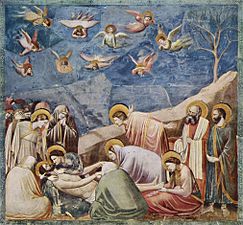
Wall fresco by Giotto, Scrovegni Chapel

Prosecco hill near Valdobbiadene

Torcello: Santa Maria Assunta and Santa Fosca

Hotel des Bains in Lido
activities
- Gardaland in Castelnuovo del Garda (on Lake Garda), Italy's largest amusement park
- The waterfall park Parco delle Cascate in Molina, north of Verona, invites you to go hiking.
- Hiking and climbing in the Dolomites
- Winter sports in the Venetian Alps. The most famous ski area in the region is Cortina d'Ampezzo
- Opera visit in La Fenice Theater Venice, in the arena from Verona or im Teatro Olimpico in Vicenza - the three are among the most famous and impressive stages in Europe
_-_panoramio.jpg/300px-Passo_Falzarego_-_Viev_from_ski_resort_(Cortina_d'Ampezzo_)_-_panoramio.jpg)
Cortina d'Ampezzo ski area

Teatro La Fenice, Venice
kitchen
Typical regional foods and geographically protected products:
- Grana Padano and Asiago cheese
- Bassano and Cimadolmo asparagus
- Lamon beans

Grana Padano
.jpg/300px-Asiago_cheese_(1).jpg)
Asiago cheese

Asparago bianco di Bassano del Grappa
- The Radicchio is the cult vegetable in Treviso and Castelfranco. The harvest begins in mid-November after the first night frosts and lasts into February. The bitter vegetables are used in many ways in local cuisine and should definitely be tried when visiting in season.
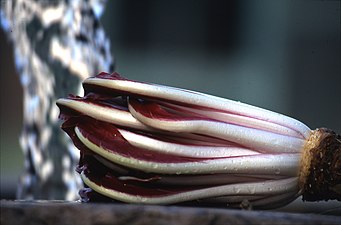
Radicchio Rosso di Treviso

Penne al Radicchio
.jpg/338px-Risotto_with_radicchio_and_oranges_(32407613653).jpg)
Risotto with radicchio
- The Risotto is a northern Italian rice dish. Medium-grain rice is important for a creamy risotto that should remain al dente (with a bite). The rice variety Vialone Nano from the Veronese Plain is particularly suitable for risotto. There is also the Piedmont Rice varieties Carnaroli and Arborio.
Risi e bisi - rice with peas is typical

Vialone Nano
- Sopressa (matured, spicy salami), especially Sopressa Vicentina (from Vicenza) and Prosciutto Veneto Berico-Euganeo (ham)
- the world famous Italian dessert Tiramisu originally from Veneto

Sopressa with polenta and mushrooms
Beverages:
- Prosecco from Conegliano and Valdobbiadene
- Red wines from the Valpolicella area (Amarone della Valpolicella, Valpolicella Ripasso, Recioto della Valpolicella) or Bardolino
- White wines from Lugana, Soave or Custoza
- Grappa veneta
nightlife
security
climate
| Venice climate | Jan | Feb | March | Apr | May | Jun | Jul | Aug | Sep | Oct | Nov | Dec | ||
|---|---|---|---|---|---|---|---|---|---|---|---|---|---|---|
| Mean highest air temperature in ° C | 5.8 | 8.2 | 12.0 | 16.3 | 21.2 | 24.8 | 27.5 | 27.0 | 23.6 | 18.1 | 11.5 | 6.7 | O | 16.9 |
| Mean lowest air temperature in ° C | -0.9 | 0.7 | 3.8 | 7.9 | 12.3 | 15.9 | 17.8 | 17.3 | 14.2 | 9.4 | 4.2 | 0.0 | O | 8.6 |
| Average water temperature in ° C | 9 | 8 | 10 | 13 | 17 | 21 | 23 | 24 | 21 | 18 | 14 | 11 | O | 15.8 |
| Precipitation in mm | 37 | 48 | 61 | 78 | 65 | 69 | 52 | 69 | 59 | 77 | 94 | 61 | Σ | 770 |
| Rainy days in the month | 7 | 6 | 7 | 8 | 8 | 9 | 6 | 7 | 5 | 6 | 8 | 6 | Σ | 83 |
| Length of sunshine per day | 2.6 | 3.8 | 4.6 | 5.8 | 7.4 | 8.1 | 9.3 | 8.3 | 6.6 | 4.9 | 2.9 | 2.5 | O | 5.6 |
Source:Wetterkontor | ||||||||||||||







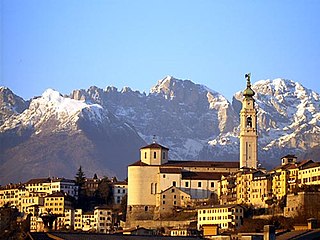










_scena_.jpg/263px-Interior_of_Teatro_Olimpico_(Vicenza)_scena_.jpg)


.jpg/339px-Peschiera_del_Garda_-_panoramio_(1).jpg)




_-_panoramio.jpg/300px-Passo_Falzarego_-_Viev_from_ski_resort_(Cortina_d'Ampezzo_)_-_panoramio.jpg)


.jpg/300px-Asiago_cheese_(1).jpg)



.jpg/338px-Risotto_with_radicchio_and_oranges_(32407613653).jpg)


